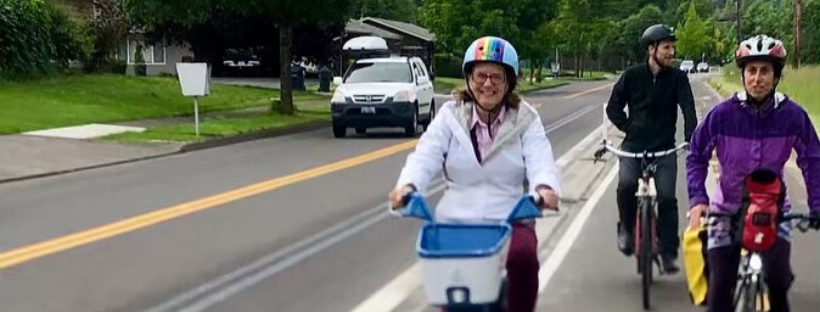BEST calls for more state funding for active transportation, slowing climate change
BEST and other transportation leaders are calling on the Oregon Transportation Commission to direct more of Oregon’s share of the federal Infrastructure Investment and Jobs Act to active transportation and slowing climate change.

President Joe Biden signed the Infrastructure Investment and Jobs Act (IIJA), a.k.a., the Bipartisan Infrastructure Law, on November 15, 2021. It is the largest long-term investment in the nation’s infrastructure and competitiveness in nearly a century.
Oregon expects to receive approximately $1.2 billion from the IIJA. About $800 million of that funding is directed to specific purposes. These include $268 million to fix bridges, $52 million to expand electric vehicle charging, $82 million for carbon reduction, and $94 million for natural disaster resiliency. See this infographic.
That leaves the state with about $412 million in discretionary funding.
BEST joined other organizations in the Clean and Just Transportation Network (CJTN) in a letter (see below) to Governor Kate Brown and the Oregon Transportation Commission (OTC): “This is a unique opportunity for Oregon’s transportation decision-makers to demonstrate climate and equity leadership while creating good family-wage jobs in allocating funding for statewide transportation infrastructure.”
Oregon Department of Transportation (ODOT) staff are proposing four scenarios for how the state could invest the flexible federal funds:
- Fix-It: This scenario focuses on providing resources to preserve existing state highways, dedicating half of the remaining flexible funding to Fix-It programs while splitting the remaining funding between Enhance Highway and Public and Active Transportation (Great Streets and Safe Routes to School).
- Public and Active Transportation: This scenario dedicates half of the remaining flexible funding to the Great Streets and Safe Routes to School programs while giving a quarter each to Enhance Highway and Fix-It.
- Enhance Highway: This scenario dedicates about half of the remaining flexible funding to Enhance Highway programs; Fix-It and Public and Active Transportation each get about a quarter of funding.
- Balanced: Each of the three categories receives about a third of the remaining funding in this scenario.
State Rep. Khanh Pham (D-Portland), joined by BEST and other transportation leaders, are advocating for a Scenario 2B: Oregon’s Values, a variation on Scenario 2, to invest in active transportation, slowing climate change, and local transportation needs.
In a letter (see below), BEST and other advocates urged the OTC “to prioritize IIJA funding for: 1) A more progressive spending scenario that more explicitly prioritizes people who walk, bike, roll, and take transit, as well as climate and equity considerations; and 2) Climate-Friendly and Equitable Communities rule-making implementation, with a primary focus on updates of Transportation System Plans (TSPs) and planning and designating Climate-Friendly Areas (CFAs).”
In addition to BEST, the letter was signed by 1000 Friends of Oregon, Bend Bikes, Central Oregon LandWatch, Oregon Environmental Council, and The Environmental Center. The letter was also sighed by former Development planner Bob Cortright and planner Jonathan Harker.

At a meeting on Thursday, February 17, nearly two-dozen people testified to the OTC about how Oregon should allocate flexible funding from the IIJA Most general preferred an emphasis on active transportation.
On Thursday, February 24, from 6:30 to 8:00 p.m., ODOT will host a virtual forum via Zoom to gather public feedback.
Through Monday, February 28, ODOT is also offering an online open house to learn more about the options and to submit comments.
By Tuesday, March 8, you can submit comments to the OTC.
At their meeting on Thursday, March 10, the OTC will provide direction on how to allocate the flexible portion of Oregon’s share of the IIJA funds.
Further reading
- Infrastructure Investment and Jobs Act 2021 (ODOT)
- Oregon eyes $1.2 billion for transportation thanks to Biden infrastructure plan (BikePortland, 11/8/21)
- ODOT says US DOT Sec Pete Buttigieg will be Oregon’s ‘new best friend’ (BikePortland, 11/17/21)
- MEETING (OTC, 11/18/21)
- Agenda Item F: Update on the Federal Infrastructure Bill
- Video
- Oregon ponders how to spend feds’ $1.2B on transportation (Portland Tribune, 11/18/21)
- What Will $1.2 Billion in Additional Funds Mean to Oregon’s Transportation Future? (ODOT, 11/19/21)
- Time to tell ODOT how they should spend $1.2 billion (BikePortland, 11/30/21)
- WEBINAR: Infrastructure Investment and Jobs Act: Implications for Oregon (ODOT, 12/7/22)
- New plan and federal funding could be opportunity for statewide transportation reform (BikePortland, 1/14/22)
- MEETING (OTC, 1/20/22)
- Agenda Item K: Discussion of Infrastructure Investment and Jobs Act (IIJA) Flexible Highway Program Funds
- Video
- ODOT and advocates lay out different plans for federal funding influx (BikePortland, 1/20/22)
- ODOT: Speak up now about use of federal flexible money (Portland Tribune, 1/22/22)
- How should we spend $400 million in federal flexible funding? Make your voice heard! (ODOT, 2/4/22)
- Call to Action: How We Can Transform Oregon’s Transportation Future (Verde, 2/9/22)
- Tell OTC & ODOT how you want our money spent! (The Street Trust, 2/11/22)
- MEETING (OTC, 2/17/22)
- Agenda Item B: Discussion of Infrastructure Investment and Jobs Act (IIJA) Dedicated Program Funds
- Video
- Oregonians testify their support of bike, pedestrian, and public transportation spending (OPB, 2/17/22)
- Oregon elected officials make plays for how to spend federal transportation dollars (Oregonian, 2/17/22)
- Portland Politicians Overwhelmingly Endorse Activist-Led Transportation Funding Plan (Portland Mercury, 2/18/22)